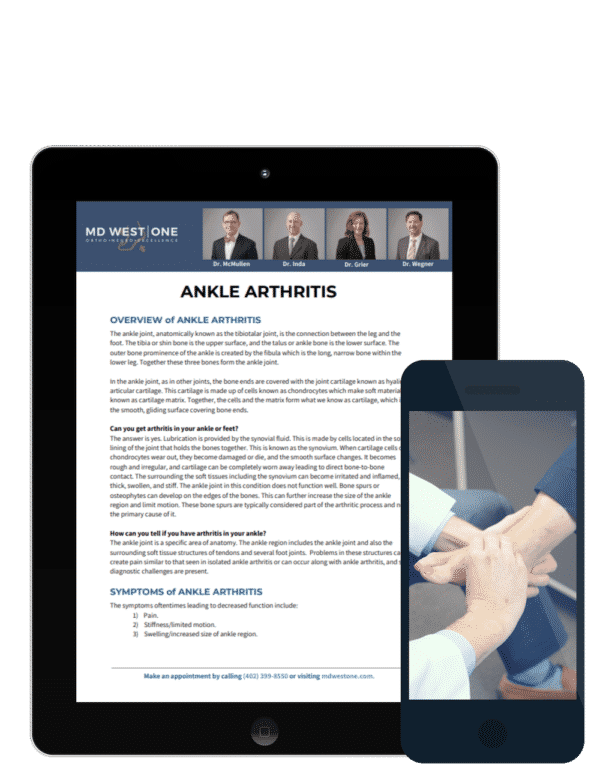Ankle Arthritis Symptoms, Causes & Treatment
The Omaha Foot & Ankle Specialists at MD West ONE are able to properly diagnose and treat ankle arthritis through both surgical and non-surgical treatments. If you have the following symptoms, you may want to make an appointment with one of our Board Certified Specialists.
- Pain in the ankle
- Stiffness/limited motion in the ankle
- Swelling/increased size of ankle region
- Functional instability which is the feeling of giving way or the joint “giving out”
- Deformity in the ankle
Meet MD West ONE's foot and ankle specialists and learn more about how they treat ankle arthritis.
OVERVIEW of ANKLE ARTHRITIS
The ankle joint, anatomically known as the tibiotalar joint, is the connection between the leg and the foot. The tibia or shin bone is the upper surface, and the talus or ankle bone is the lower surface. The outer bone prominence of the ankle is created by the fibula which is the long, narrow bone within the lower leg. Together these three bones form the ankle joint.
In the ankle joint, as in other joints, the bone ends are covered with the joint cartilage known as hyaline articular cartilage. This cartilage is made up of cells known as chondrocytes which make soft material known as cartilage matrix. Together, the cells and the matrix form what we know as cartilage, which is the smooth, gliding surface covering bone ends.
Can you get arthritis in your ankle or feet?
The answer is yes. Lubrication is provided by the synovial fluid. This is made by cells located in the soft lining of the joint that holds the bones together. This is known as the synovium. When cartilage cells or chondrocytes wear out, they become damaged or die, and the smooth surface changes. It becomes rough and irregular, and cartilage can be completely worn away leading to direct bone-to-bone contact. The surrounding the soft tissues including the synovium can become irritated and inflamed, thick, swollen, and stiff. The ankle joint in this condition does not function well. Bone spurs or osteophytes can develop on the edges of the bones. This can further increase the size of the ankle region and limit motion. These bone spurs are typically considered part of the arthritic process and not the primary cause of it.
How can you tell if there is arthritis in your ankle?
The ankle joint is a specific area of anatomy. The ankle region includes the ankle joint and also the surrounding soft tissue structures of tendons and several foot joints. Problems in these structures can create pain similar to that seen in isolated ankle arthritis or can occur along with ankle arthritis, and so diagnostic challenges are present.
DIAGNOSIS of ANKLE ARTHRITIS
Diagnosis of ankle arthritis is typically made with the findings of a physical exam and x-ray evaluation. Advanced imaging such as a CT or MRI scan can be helpful at times depending on exam and x-ray findings.
CAUSES OF ANKLE ARTHRITIS
Ankle injury
Injuring the ankle joint can lead to direct cartilage damage or may be related to the indirect effect of cartilage wear in a joint that has had multiple ligament injuries and is not mechanically stable. When a fracture or broken bone occurs into the small cartilage surface, this can lead to direct cartilage damage, and over time further cartilage deterioration can occur. This is known as post-traumatic arthritis.
Can spraining your ankle cause ankle arthritis?
Ligament injuries of the ankle, such as multiple ankle sprains, can lead to an ankle joint that is not stable. Over time, this can create wearing of the cartilage surface, and this can lead to ankle arthritis.
Can a broken ankle cause ankle arthritis?
Fractures within the talus bone can damage the blood supply leading to areas of the talus bone that further deteriorate and collapse. This is known as osteonecrosis. Cartilage overlying an area of osteonecrosis can deteriorate leading to ankle arthritis. Small areas of damage to bone and cartilage, known as osteochondral lesions of the talus, can occur developmentally and can occur following trauma. Over time, these areas can enlarge and create additional cartilage deterioration within the joint and arthritis.
Time and genetics
Over time, with the natural aging process, even without specific injuries, cartilage surfaces can wear out leading to arthritis. In some individuals, there may be a genetic predisposition for the cartilage to wear out at a faster rate than in others. This degenerative joint process is known as osteoarthritis.
Systemic inflammatory arthritis/rheumatoid arthritis
Some patients have autoimmune or whole body inflammatory conditions. In these conditions, the body’s immune systems and inflammatory cells can damage the joints leading to arthritis. Rheumatoid arthritis would be an example of a systemic autoimmune condition, and gout is an example of a systemic condition that can lead to joint inflammation and damage.
Infection
An active bacterial infection within a joint space can significantly damage the cartilage leading to arthritis. This is known as post-septic arthritis.
Obesity
Although obesity may not specifically create isolated joint damage, patients above ideal body weight do have greater forces across weight-bearing joints. This can contribute to or accelerate the arthritic process.
EVALUATION of ANKLE ARTHRITIS
The three main components of diagnosing ankle arthritis include the history and physical examination and x-rays. The patient history or description of the process is very important. This includes current symptoms and also past symptoms.
Previous activities and injuries, medical diagnoses, and family history are also important. The physical exam can reveal specific areas of tenderness. Mechanical findings may include limited motion, roughness with joint motion, joint instability, and swelling. X-rays are a routine evaluation component. X-rays taken while standing are ideal in order to show the ankle appearance when weight bearing occurs.
Depending on the findings of these three basic components, advanced imaging may be helpful to further evaluate the joint and surrounding soft tissues. These include CT scanning, MRI scanning, and ultrasonography. Laboratory testing is not a routine component of evaluating ankle arthritis but may be requested depending upon a person’s medical diagnoses and/or family history.
EXERCISES for ANKLE ARTHRITIS
Maintaining joint motion and soft tissue flexibility is important. However, moving and working the arthritic ankle joint can further aggravate symptoms and create additional structural damage.
Exercises specifically for the treatment of ankle arthritis symptoms must be prescribed on an individual patient basis.
NON SURGICAL TREATMENTS for ANKLE ARTHRITIS
The overall goal of treatment is to decrease pain and improve function. To do this, it can be helpful to change the mechanical stresses across the joint and to decrease tissue inflammation.
Activity modifications
Adjust walking distances as much as possible and avoid uneven surfaces. Change from high impact running and jumping aerobic activities to lower impact forms of exercise such as bicycling or elliptical workouts.
Medications
Acetaminophen - This is a non-narcotic over-the-counter pain reliever that can be effective for reducing painful symptoms.
Non-steroidal anti-inflammatory drugs or NSAIDs - Nonsteroidal anti-inflammatory drugs or NSAIDs can help control pain as well as decrease joint inflammation and swelling. The most common options available without a prescription include ibuprofen and naproxen. There are also numerous prescription NSAIDs available.
Steroids
Oral steroids can be used for the management of ankle arthritis. However, it would typically occur when there is a systemic arthritic process present such as rheumatoid arthritis or similar diagnosis.
Bracing/shoe modifications
A stiff shank/rocker sole shoe can assist with creating a heel-to-toe walking pattern and taking stress of the ankle joint.
- Soft ankle brace - This type of device provides compression around the ankle region, mechanical support and immobilization to help reduce symptoms and improve function. An effective design includes a lace-up application with adjustable crisscrossing straps for support.
- Rigid brace - This type of brace limits motion and reduces stress across the ankle joint to a greater degree. This would typical be a custom-molded brace such as an AFO (ankle/foot orthosis) or a specialized AFO known as an ankle gauntlet AFO. These braces are worn within a shoe, but they can be thick and cumbersome. The traditional metal brace, known as a double upright brace, attaches directly to a shoe or a boot.
INJECTIONS
Cortisone
The most common type of injection for ankle arthritis is cortisone. A cortisone medication, oftentimes combined with a local anesthetic can be injected into the arthritic ankle. When effective, this can significantly reduce or resolve joint pain for a period of time. The amount of pain relief and the duration can be variable and is not always predictable.
Viscosupplementation
This involves injecting a lubricant substance into the joint. Currently, the substances available are FDA approved for use only in the knee joint. They are believed to be safe for use in other joints. However, the effectiveness in other joints has not been extensively studied and proven. Use in the ankle is concerned “off-label”, and the substances typically are not covered by insurance carriers. Results expected can be similar to those of cortisone injections.
Growth factors/stem cells
The use of platelet-containing fluid from a patient’s blood or concentrated bone marrow cells may also be injected into the ankle joint. This therapy has been shown to be safe. However, it has not been shown to improve damaged joint cartilage, and symptom relief can be limited. The process can be very expensive and is typically not covered by insurance carriers.
While corticosteroid injections are quite common, the use of viscosupplementation and growth factors/stem cells are not components typically used by the foot and ankle specialists of MD West ONE. However, we are happy to discuss them.
SURGICAL TREATMENTS for ANKLE ARTHRITIS
Ankle Arthroscopy
Arthroscopic surgery can be useful in patients with more minor or limited ankle arthritis. It can be ineffective in more extensive ankle arthritis. At times, symptoms may even worsen for a period of time if extensive arthritis is present.
Ankle arthroscopy may be helpful when there is a loose piece of bone known as a loose body within the joint or if there is a small area of soft tissue and bony prominence creating ankle “impingement”. Small rough areas of cartilage may be smoothed which can help improve symptoms. However, when it is more extensive, this will typically not be helpful. Stabilizing torn or unstable ligaments may also be a necessary part of an arthroscopic ankle procedure.
Ankle Fusion
Fusion is the permanent locking together of a joint. Arthrodesis is another term for fusion. This still remains one of the most common and effective surgical treatments for ankle arthritis. This can be performed using an arthroscopic technique or a larger open surgical approach. In a fusion surgery, any remaining damaged cartilage is removed along with the hard, irregular bone surfaces. Essentially, the bone surfaces are broken up or micro-fractured to create a healing response similar to that of healing a broken bone. Oftentimes a bone graft material is added to enhance the local biologic healing.
The bone ends are compressed and held together with internal devices such as bone screws or plates and screws together. The importance of the internal hardware is to hold the bone securely while the bone healing occurs. It can take several months for full bone healing to occur. The internal hardware is typically left in place unless there is a specific problem which would require its removal. Healing of the bones can take longer than anticipated, and this is known as a delayed union. Healing of the bone may not occur at all, and this is known as a nonunion.
Revision surgery may be needed in these situations. Factors contributing to the delayed or non-healing of the bone can include nicotine use or weight bearing sooner than instructed. Following ankle fusion, arthritis in the foot joints can develop or progress, and symptoms may or may not develop. It is important to realize that ankle fusion can be a very effective way to improve the painful symptoms of ankle arthritis and improve function.
Ankle Replacement
Ankle replacement has been done for several decades but has not achieved a level of success and predictability that hip and knee replacement surgeries have. In ankle replacement surgery, the ankle joint surfaces of the tibia and the talus are removed and resurfaced with metal components. In between the metal components is a plastic material known as polyethylene.
In a two-piece design, the plastic attaches to the metal component of the tibia, and in a three-piece design, it is unattached and is allowed to move and rotate. Replacing the ankle has the advantage of maintaining motion, which may allow for a more fluid walking cycle and may help to minimize the transfer of stress to foot joints as has been seen with fusion.
However, mechanical wear and stability issues can develop leading to pain, dysfunction, instability and collapse of the bone. Revision joint replacement options in the ankle are limited, and obtaining a fusion after a failed ankle replacement can be difficult and is more challenging than a primary ankle joint fusion.
POSTOPERATIVE RECOVERY of ANKLE ARTHRITIS SURGERY
Elevation
Following ankle surgery, one of the most important factors is elevation of the operative extremity. Swelling following ankle surgery can be pronounced, and extensive swelling can increase pain and compromise healing of the skin and soft tissues. Applying ice to the operative area, particularly in the first 48 hours, can also be helpful.
Immobilization
The ankle joint is typically immobilized in a rigid device. This can be a hard splint made of plaster or fiberglass or a removable boot known as a CAM boot. Immobilization following ankle surgery typically covers the foot, ankle, and leg and extends up to just below the knee. Splints are sometimes referred to as partial casts as they are not hard around the entire ankle and leg area. They allow more room for swelling to occur. The CAM boot is a removable device, but your surgeon may give specific instructions as to whether or not it may be removed. Splints are to be left in place. The first postoperative visit can occur approximately one to two weeks following surgery. Dressings are removed as are sutures and staples if incisions are healed. Immobilization after this will depend on the specific surgery performed.
Restricted weight bearing
Following ankle surgery for arthritis, weight bearing is not allowed on the operative extremity until the first postoperative visit and oftentimes is continued until 6 to 8 weeks postoperatively. Following the period of non-weight bearing, there is a period of partial weight bearing which can last up to 6 weeks. During this time, weight bearing is allowed on the operative extremity typically while using a removable boot, and weight bearing is shared with the arms. Devices used during the restricted weight bearing time include crutches, walker, knee scooter, or a wheelchair.
X-rays
X-rays may be utilized in the postoperative period to evaluate for bony healing. This is particularly necessary in the situation of ankle fusion.
Postoperative expectations
Patients can expect surgical pain for at least several days, and it can last for several weeks. This can involve the use of oral narcotic medications with the goal being the steady decline of use within the first five to seven days. Depending on the specifics of the procedure and the status of the individual patient, discharge to home may occur the same day or within 24 hours of surgery and at times can require additional time in the hospital. Swelling is expected and, although it will decline, it may take months to reach a final plateau. Ankle reconstructions for arthritis can be quite extensive and the full benefits of surgery sometimes can take up to nine to twelve months to realize.
The foot and ankle subspecialists of MD West ONE will help you through the detailed evaluation process by creating an individualized treatment plan to help maximize your function and treatment success.
AMERICAN ORTHOPAEDIC FOOT & ANKLE SOCIETY
All of the foot and ankle surgeons in the practice are recognized members of the American Orthopaedic Foot & Ankle Society. It is the oldest and most prestigious medical society dedicated to the foot and ankle. The mission of the society is to advance science and practice of foot and ankle surgery through education, research, and advocacy on behalf of patients and practitioners. These physicians dedicate their time and energy to improving the patient experience and their knowledge in their field. For more information visit http://www.aofas.org.
MD West ONE Foot & Ankle Specialists:
The Foot & Ankle Specialists are all Board Certified and Fellowship-Trained, meaning they’ve focused their education, training and research on orthopaedic surgery of the foot and ankle.






